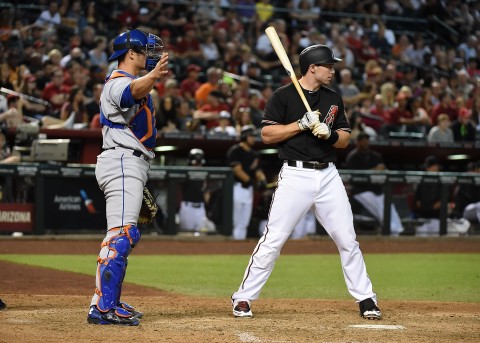The latest rule change in baseball shaves seconds off the game.
If you head out to a Major League Baseball game anytime soon, there’s something you’re likely going to miss:
- As in you’re going to miss seeing it because it’s gone. It’s history.
- Also as in you’re going to miss it because it’s going to happen so fast, you won’t know it happened.
- Oddly enough, both misses are brought about by the same new rule change.
No longer in any MLB game will there be an intentional walk involving four purposely thrown balls.
Now, when a team wants to issue an intentional walk (officially notated as IBB, for intentional base on balls), the manager simply signals to the umpire that he intends to intentionally walk the batter who is coming up or is at the plate at the time.
It’s not clear what that signal from the manager is. Does he yell “Time!” and rub his stomach? Or pretend to walk in place? Not clear. He just “signals.”
It’s also not clear what the umpire says to the batter who’s been walked intentionally. It might be “Take your base,” or “You’ve just been granted an intentional walk” or “Get outta here and go stand on first.” It’s just not all that clear.
On one website, this explanation of the rule and process was provided, which may or may not be the official language:
“[One new rule is] the start of a no-pitch intentional walk, allowing the defensive team’s manager to signal a decision to the home plate umpire to intentionally walk the batter. Following the signal of the manager’s intention, the umpire will immediately award first base to the batter.”
Whatever it all means, when the manager signals the umpire, the batter immediately takes first.
History made.
You can challenge your friends with this trivia question: Who was the first player to be issued the no-pitch intentional walk?
The answer is Yadier Molina, catcher for the St. Louis Cardinals. It happened in the very first game of the 2017 season against the Cubs.
It’s taking some time for players to get used to the new rule. In the Angels’ first game this season, Mike Trout had stretched a single into a double and was on second with no outs in the 8th inning against the A’s. Albert Pujols was about to settle into the batter’s box. Trout was sizing up the situation.
When Trout looked at home, Pujols wasn’t in the batter’s box. Instead, he was already standing on first base. According to the Los Angeles Times, Trout and Pujols just looked at each other and laughed.
The “free pass” is now the “fast pass.”
Why the change?
Supposedly, eliminating the four-pitch intentional walk is seen as an important tool for speeding the game up, or at least to give fans a more entertaining experience. Commissioner of Baseball Rob Manfred is on a campaign to improve the game for fans, and most changes of late have involved trying to accelerate the “pace of game,” as Major League Baseball refers to it.

Here’s what the commissioner said before the season:
“I think it’s a mistake...to ignore the fact that our game has changed and continues to change.... Last year, balls in play were at a record low, and we all know that things like the use of relief pitchers has changed dramatically in the last 30 years. I’m firmly convinced that our fans—both our avid fans and casual fans—want us to respond to and manage the change that’s going on in the game.”
Still, most people think that eliminating the four-pitch intentional walk isn’t really going to do much to speed up the game or improve it. And if you look at the numbers, they are absolutely right about that.
According to official MLB statistics for 2016, there were 932 intentional walks issued during the entire MLB season. Number crunching concludes that works out to one intentional walk for every three games.
Not exactly what you’d call a disruptive occurrence.
Why pick on the intentional walk?
As it turns out, the intentional walk has been targeted before. Before the start of the 1920 season, baseball owners proposed a rule change that would penalize a team for intentionally walking a batter: Their idea was walk a guy and get charged an automatic balk, which would advance any runners on base.
Their thinking, interestingly along the same lines as recent rule-change ideas, was that move could increase scoring and help boost attendance. Their proposal wasn’t granted.
However, a new wrinkle for the intentional walk was introduced: From that season on, the catcher had to stand up and call for the pitches by sticking out his arm while standing in the batter’s box. That’s the way it’s been from then till now.
At least, till the end of last year’s World Series.

And that’s why—or how—some pitchers have thrown a wild pitch when simply trying to throw an intentional ball, allowing a runner on third (or second) base to score a winning run.
And it’s why a handful of players have been able to swing and reach out enough to get a piece of a ball for a hit, and even drive in a go-ahead run in extra innings. (You can see it on YouTube. Miguel Cabrera of the Tigers against the Baltimore Orioles, 2006.) The last guy to get his bat on an errant intended intentional ball was Gary Sanchez of the Yankees in 2016. He ended up hitting a sac fly, driving in a run.
So, how many times do you think a batter has gotten a base hit off an intentional ball? You might be surprised. Only 12 times in the past 100 years, according to the Society for American Baseball
Research.
Miguel Cabrera’s 2006 base hit was the last one. And unless the rule changes again, it will remain the last one forevermore.
Resources: sabr.org; https://en.wikipedia.org; latimes.com; http://m.yankees.mlb.com

